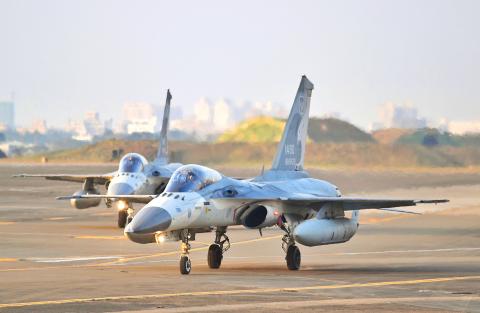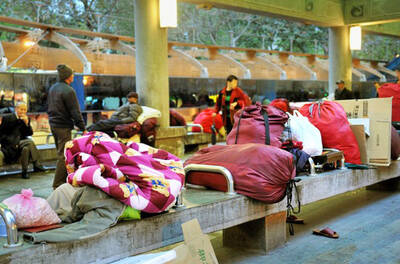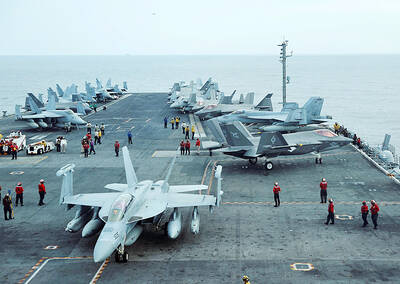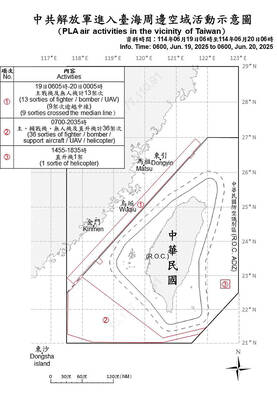The Ministry of National Defense has announced that it plans to develop a new generation of homegrown fighter jets with stealth capabilities as part of the government’s policy to develop an indigenous defense industry.
“Building homegrown aircraft and vessels has become an extremely important policy of the ministry since President Tsai Ing-wen (蔡英文) assumed office. Progress has been made in building indigenous vessels and there is another promise the ministry has to keep, which is to develop a new generation of fighter jets,” Minister of National Defense Feng Shih-kuan (馮世寬) said on Monday.
Feng made the announcement during a meeting with reporters, but did not give any details about the design or functions of the new aircraft.

Photo: CNA
According to reports, the new fighter jet is to be a double-engine stealth plane developed with Taiwanese technology.
The National Chung-Shan Institute of Science and Technology has reportedly been developing the engine technology based on the model fitted on the Indigenous Defense Fighter (IDF).
The air force’s Aviation Technology Research Center is also to be responsible for the development of the new fighter jets.
The research center, though receiving little public attention, is critical for refining the nation’s air defense capabilities in the next 10 to 20 years, Feng said.
While the nation is still seeking to procure F-35Bs, the short takeoff and vertical-landing variant of the US stealth jet that could satisfy the nation’s defense needs due to the vulnerability of air bases, Taiwan has to develop its own fighter jets to maintain its defense capabilities and increase the possibility of procurement, Feng said.
The development of homegrown fighter jets is key to the nation’s defense industry, as Aerospace Industrial Development Corp, which designed and built the IDF when it was an air force research division, is now the nation’s largest defense company, Feng said.
However, senior military analyst Erich Shih (施孝瑋) said that the IDF engine, with its inadequate thrust, could not be used to power next-generation fighter jets.
A capable engine on next-generation fighter jets should produce at least 24,000 pounds of thrust, but an IDF’s two engines can only produce up to 18,000 pounds of thrust, making the IDF engine unfit for the new jets, Shih said.
Since the development of the IDF in the 1990s, Taiwan has made little progress in military aviation or technological cooperation with other nations — such as an aborted plan to partner with an Italian manufacturer to build trainer jets for the air force — but building new jets is a more efficient option, both technologically and financially, to advance the nation’s aerospace industry, he said.

A year-long renovation of Taipei’s Bangka Park (艋舺公園) began yesterday, as city workers fenced off the site and cleared out belongings left by homeless residents who had been living there. Despite protests from displaced residents, a city official defended the government’s relocation efforts, saying transitional housing has been offered. The renovation of the park in Taipei’s Wanhua District (萬華), near Longshan Temple (龍山寺), began at 9am yesterday, as about 20 homeless people packed their belongings and left after being asked to move by city personnel. Among them was a 90-year-old woman surnamed Wang (王), who last week said that she had no plans

TO BE APPEALED: The environment ministry said coal reduction goals had to be reached within two months, which was against the principle of legitimate expectation The Taipei High Administrative Court on Thursday ruled in favor of the Taichung Environmental Protection Bureau in its administrative litigation against the Ministry of Environment for the rescission of a NT$18 million fine (US$609,570) imposed by the bureau on the Taichung Power Plant in 2019 for alleged excess coal power generation. The bureau in November 2019 revised what it said was a “slip of the pen” in the text of the operating permit granted to the plant — which is run by Taiwan Power Co (Taipower) — in October 2017. The permit originally read: “reduce coal use by 40 percent from Jan.

China might accelerate its strategic actions toward Taiwan, the South China Sea and across the first island chain, after the US officially entered a military conflict with Iran, as Beijing would perceive Washington as incapable of fighting a two-front war, a military expert said yesterday. The US’ ongoing conflict with Iran is not merely an act of retaliation or a “delaying tactic,” but a strategic military campaign aimed at dismantling Tehran’s nuclear capabilities and reshaping the regional order in the Middle East, said National Defense University distinguished adjunct lecturer Holmes Liao (廖宏祥), former McDonnell Douglas Aerospace representative in Taiwan. If

‘SPEY’ REACTION: Beijing said its Eastern Theater Command ‘organized troops to monitor and guard the entire process’ of a Taiwan Strait transit China sent 74 warplanes toward Taiwan between late Thursday and early yesterday, 61 of which crossed the median line in the Taiwan Strait. It was not clear why so many planes were scrambled, said the Ministry of National Defense, which tabulated the flights. The aircraft were sent in two separate tranches, the ministry said. The Ministry of Foreign Affairs on Thursday “confirmed and welcomed” a transit by the British Royal Navy’s HMS Spey, a River-class offshore patrol vessel, through the Taiwan Strait a day earlier. The ship’s transit “once again [reaffirmed the Strait’s] status as international waters,” the foreign ministry said. “Such transits by